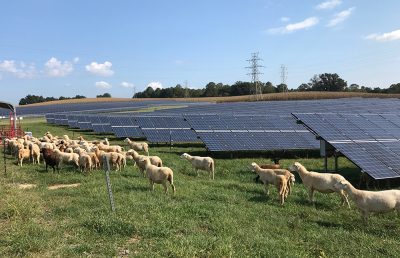AV's Intern Team | October 11, 2017 | No Comments
By Otto Solberg
Although solar fields generate large amounts of renewable energy, the ground underneath is commonly planted with turf grasses that do not effectively drain rainwater and require carbon-wasting maintenance. These innovative applications of solar energy are minimizing those negative impacts and creating more benefits for incorporating solar.

Photo courtesy of Sun-Raised Farms
To maintain the land under solar fields and keep plants from shading the panels, sheep may be the animals for the job. Sun-Raised Farms is a North Carolina collective of farmers who use sheep to graze grass and weeds around solar fields to prevent the need for mowers or pesticides. The technique will also be employed at a solar farm being built by Secure Futures and Sun Tribe Solar in Virginia’s New River Valley.
The Piedmont Biofarm in Pittsboro, N.C., is proving that solar fields can co-exist with productive farmlands. By raising panels higher and spacing them out, they can create shade for crops without completely blocking the sunlight. The shade can help cool-weather crops like lettuce and arugula as global temperatures increase and can protect sensitive plants like tomatoes from rain.
Maryland followed Minnesota to become one of the first states to pass pollinator-friendly legislation for solar facilities. Planting native grasses and flowers instead of turf fields can provide healthy habitats for butterflies and struggling bee populations, while requiring less maintenance and allowing better water infiltration for the soil.
Chattanooga Airport took advantage of the otherwise unused grass fields around their runways to add nearly 7,500 solar panels across 7.5 acres. This Tennessee solar farm is cutting the airport’s power expenses by up to 85 percent and airport officials say they are looking to expand the solar array.
In Hagerstown, Md., Volvo Group recognized their large parking lots as an opportunity to install over 5,000 solar panels. The solar canopy above the lot provides 10 to 15 percent of the energy the manufacturer requires, while also shading the parking lot and providing charging stations for electric cars.
Cities and college campuses are implementing solar trash compactors, park benches and bus stops into public spaces. Trash compactors reduce collection trips by approximately 80 percent while solar benches and bus stops provide free charging stations in convenient public spaces.
A nonprofit organization, Clinic-in-a-Can, outfits shipping containers with medical equipment and solar panels to create self-sufficient and easily transportable clinics for areas where traditional hospitals are impractical. Two were deployed to Houston to help with disaster relief after Hurricane Harvey.
If you know of other exciting uses for solar power or fields in the region, please let us know by emailing voice@appvoices.org.
Like this content? Subscribe to The Voice email digests